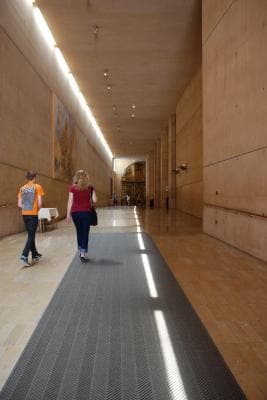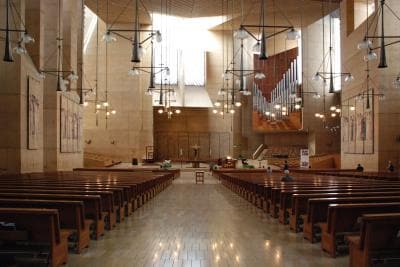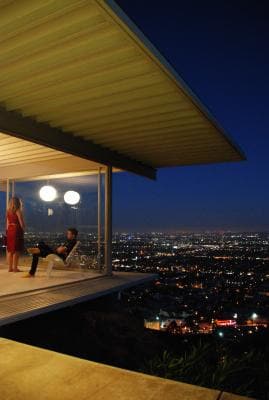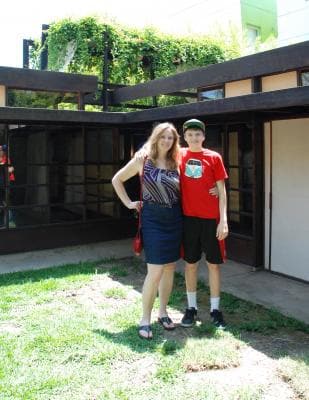The highlight of this summer was an opportunity to treat my son, Aaron, along with my wife, Beverly, to a Los Angeles architectural tour, thereby carrying on a rite of passage I experienced 30 years ago. As a teenager, I periodically took road trips to L.A. with architect Arthur Dyson, whom I worked for at the time. As a former apprentice of Frank Lloyd Wright, Art would lead tours exploring the buildings of Wright and his contemporaries. It was on these trips that I heard stories of Wright and saw the architectural manifestation of the California dream. Being exposed to this formally expressive architecture had a lasting and profoundly influential influence on me.
Aaron, now a fledgling design student at a Lick-Wilmerding High School design school in San Francisco, is beginning to realize the significance of architecture relative to popular culture. As a destination, Los Angeles has a glamorous allure, especially to a high school sophomore and its popular appeal is only enhanced by the buildings we visited. L.A. offers some of the best architectural drama -- often created through site orientation and views, and in many cases, eccentric, even sceno-graphic forms. This has become a hallmark of the L.A. architectural scene, both historically and today.
Walt Disney Concert Hall, Frank Gehry, Los Angeles
Utilizing David Gebhard’s An Architectural Guidebook to Los Angeles, we reviewed potential projects and chose a group of buildings that were architecturally highly significant, aiming for a blend of historic vs. contemporary and residential vs. public. We selected buildings by Wright; his son, Lloyd Wright; Greene and Greene; R.M. Schindler; Richard Neutra; Pierre Koenig; John Lautner, and contemporary architects Frank Gehry and Raphael Moneo. There were many more we couldn’t get to, but saved on the map for another trip.
As a design destination, the choice of L.A. is not arbitrary. The Los Angeles region was such a great catalyst for architectural design expression during the first half of the 20th century—especially residential design—and it’s good to see that that spirit carries on today. Historically, this was probably due to a variety of factors: a desire to experiment formally within a landscape unsullied by historical context; an aspiration for the new and dramatic; and plentiful and beautiful land in a great climate. These factors drew an exceptional group of architects to live and work in the region including, Schindler, Neutra, Lautner, the Eames’s and Gehry, among others.


Cathedral of Our Lady of the Angels, Raphael Moneo, Los Angeles

My wife and son, The Stahl House, Pierre Koenig, Los Angeles
Although touring a building in which you can experience the interior spaces is always preferable, you can’t discount the act of personal discovery while wandering (even by car) the streets of a city and coming upon these special buildings.
In total, we saw 25 buildings and toured six over four days. Some of the many highlights included:
The Stahl house by Pierre Koenig (a favorite of my son). Beautiful expression of form in the service of the amazing L.A. basin view. Simple and elegant icon of mid-century modernism.
The Disney Concert Hall by Frank Gehry: amazing and thematically fitting, lyrical forms. A remarkable example of his personal sculptural style, gratefully open to the public for walking tours.
Raphael Moneo’s Cathedral of our Lady of the Angels: the fairly understated exterior form in the service of genuinely powerful interior spaces. The embodiment of religious passion in form.
R.M.Schindler’s Kings Road House: modest and beautiful experimental home now open for tours through the MAK center.
Additional photos of the buildings can be found here.

Kings Road House, R.M. Schindler, Los Angeles
Our son had a great time and really gained an appreciation for the contribution of good architecture to our American culture. Beyond the nostalgia, the trip reminded me that clients who invest in design, and who allow their architects to design to their skills and beliefs, are really the advocates of creating a better built-environment. Not just for themselves, but the community at large as well. These buildings have survived to become icons of our culture precisely because their owners invested in designs that have lasting value.
Lastly, I want to say that we are really grateful to those that are working to preserve and promote both the buildings and the work of these architects. Please feel free to leave comments or questions below.
